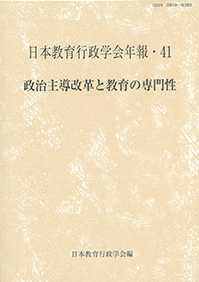Volume 41
Displaying 1-34 of 34 articles from this issue
- |<
- <
- 1
- >
- >|
I. BULLETIN FORUM
Educational Professionalism and Political Intervention
-
2015 Volume 41 Pages 2-18
Published: 2015
Released on J-STAGE: March 20, 2019
Download PDF (1424K) -
2015 Volume 41 Pages 19-36
Published: 2015
Released on J-STAGE: March 20, 2019
Download PDF (1378K) -
2015 Volume 41 Pages 37-55
Published: 2015
Released on J-STAGE: March 20, 2019
Download PDF (1411K) -
2015 Volume 41 Pages 56-69
Published: 2015
Released on J-STAGE: March 20, 2019
Download PDF (1338K) -
2015 Volume 41 Pages 70-86
Published: 2015
Released on J-STAGE: March 20, 2019
Download PDF (1371K) -
2015 Volume 41 Pages 87-90
Published: 2015
Released on J-STAGE: March 20, 2019
Download PDF (1226K)
II. RESEARCH REPORTS
-
2015 Volume 41 Pages 92-108
Published: 2015
Released on J-STAGE: March 20, 2019
Download PDF (1377K) -
2015 Volume 41 Pages 109-125
Published: 2015
Released on J-STAGE: March 20, 2019
Download PDF (1587K) -
2015 Volume 41 Pages 126-142
Published: 2015
Released on J-STAGE: March 20, 2019
Download PDF (1422K)
III. THE FORTY-NINTH ANNUAL MEETING: SUMMARY REPORTS
Public Symposium
Summary
-
2015 Volume 41 Pages 144-145
Published: 2015
Released on J-STAGE: March 20, 2019
Download PDF (1197K)
Lectures
-
2015 Volume 41 Pages 146-150
Published: 2015
Released on J-STAGE: March 20, 2019
Download PDF (1310K) -
2015 Volume 41 Pages 151-155
Published: 2015
Released on J-STAGE: March 20, 2019
Download PDF (1390K) -
2015 Volume 41 Pages 156-159
Published: 2015
Released on J-STAGE: March 20, 2019
Download PDF (1388K)
Conclusion
-
2015 Volume 41 Pages 160-163
Published: 2015
Released on J-STAGE: March 20, 2019
Download PDF (1314K)
Research Focus 1
Summary
-
2015 Volume 41 Pages 164-165
Published: 2015
Released on J-STAGE: March 20, 2019
Download PDF (1382K)
Presentation
-
2015 Volume 41 Pages 166-170
Published: 2015
Released on J-STAGE: March 20, 2019
Download PDF (1391K) -
2015 Volume 41 Pages 171-174
Published: 2015
Released on J-STAGE: March 20, 2019
Download PDF (1336K) -
2015 Volume 41 Pages 175-178
Published: 2015
Released on J-STAGE: March 20, 2019
Download PDF (1389K)
Conclusion
-
2015 Volume 41 Pages 179-182
Published: 2015
Released on J-STAGE: March 20, 2019
Download PDF (1388K)
Research Focus 2
Summary
-
2015 Volume 41 Pages 183-184
Published: 2015
Released on J-STAGE: March 20, 2019
Download PDF (1302K)
Presentation
-
2015 Volume 41 Pages 185-189
Published: 2015
Released on J-STAGE: March 20, 2019
Download PDF (1391K) -
2015 Volume 41 Pages 190-195
Published: 2015
Released on J-STAGE: March 20, 2019
Download PDF (1423K) -
2015 Volume 41 Pages 196-200
Published: 2015
Released on J-STAGE: March 20, 2019
Download PDF (1310K)
Conclusion
-
2015 Volume 41 Pages 201-205
Published: 2015
Released on J-STAGE: March 20, 2019
Download PDF (1310K)
Special Program
Summary
-
2015 Volume 41 Pages 206-207
Published: 2015
Released on J-STAGE: March 20, 2019
Download PDF (1182K)
Presentation
-
2015 Volume 41 Pages 208-211
Published: 2015
Released on J-STAGE: March 20, 2019
Download PDF (1389K) -
2015 Volume 41 Pages 212-215
Published: 2015
Released on J-STAGE: March 20, 2019
Download PDF (1309K)
IV. BOOK REVIEW
-
2015 Volume 41 Pages 218-221
Published: 2015
Released on J-STAGE: March 20, 2019
Download PDF (1374K) -
2015 Volume 41 Pages 222-225
Published: 2015
Released on J-STAGE: March 20, 2019
Download PDF (1405K) -
2015 Volume 41 Pages 226-229
Published: 2015
Released on J-STAGE: March 20, 2019
Download PDF (1374K) -
2015 Volume 41 Pages 230-233
Published: 2015
Released on J-STAGE: March 20, 2019
Download PDF (1375K) -
2015 Volume 41 Pages 234-237
Published: 2015
Released on J-STAGE: March 20, 2019
Download PDF (1374K) -
2015 Volume 41 Pages 238-241
Published: 2015
Released on J-STAGE: March 20, 2019
Download PDF (1376K) -
2015 Volume 41 Pages 242-245
Published: 2015
Released on J-STAGE: March 20, 2019
Download PDF (1374K)
- |<
- <
- 1
- >
- >|
